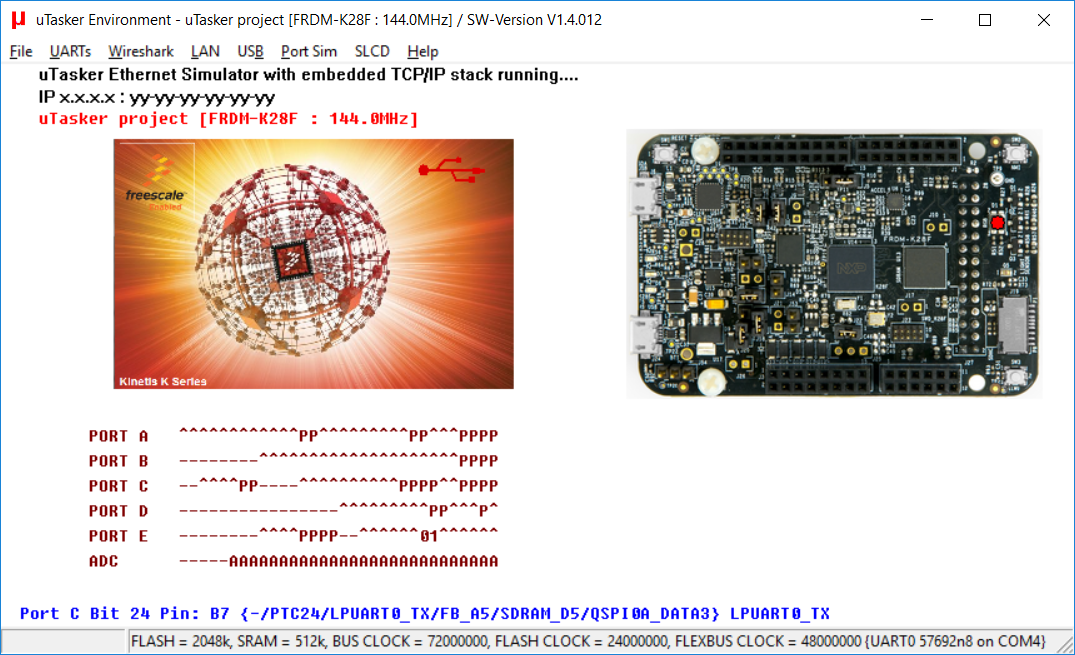FRDM-K28F

This NXP Freedom board is based on the K28FN2M0VMI15 which is a 150MHz device from the large-memory performance and integration family with Cortex-M4F core with FS and HS USB. This K28F device has 2M Flash and 1M SRAM and is in a 169 pin MAPBGA package, whereby the K28F is also available in 210-pin WLCSP. There is a 12MHz crystal on the board for optionally clocking the part, which also has various internal clocks too.
Full details and documentation for this board can be obtained from the NXP web site: FRDM-K28F
To configure the µTasker project for this board simply enable the define FRDM_K28F in the project's config.h file. The compiler needs to be set to build for Cortex M0+ (and not Cortex M4) and the linker script K_2M_1M.ld should be selected [K_2M_1M_BM.ld for downloadable version] {the linker script extension may vary for different compilers, whereby *.ld is valid for GCC}
FRDM-K28F Binaries
Here are some binary files that can be loaded to the board. These were built using the µTasker applications (serial loader and V1.4 application)
and can be simply generated using the supported compilers/IDEs [these were built using GCC], built using different configuration options or modified to
suit specific requirements or hardware derived from this board :
-
uTaskerSerialBoot_FRDM-K28F_MSD.bin USB-MSD loader [18.0k]
allowing applications to be loaded at link address 0x8080 using USB-MSD when the board appears as upload hard disk).
When operating, the green LED blinks at 5Hz. To force the loader, reset the board with push button SW3 held down.
To disable the watchdog, reset the board with push button SW1 held down.
This can be loaded using the FRDM-K28F's USB-MSD (OpenSDA) boot loader. Note that the loader limits application sizes to 128k - it can be built without limits using the µTasker project. The USB device operation on the High Speed USB interface.
The UART on the the OpenSDA's USB virtual COM port can be usd to monitor operation and also command deletion of the application code.
-
uTaskerV1.4.12_FRDM_K28F_USB-CDC_BM.bin FRDM-K28F application with command-line menu on the LPUART 0 (via the OpenSDA's USB virtual COM port connection at 115'200 Baud) with various menu items and also on a USB-CDC connection [requires no installation under Win 10].
The processor runs at 144MHz and the HS USB interface is used. [30.9k].
Linked to 0x8080, this binary image can be loaded with drag-and-drop onto the upload disk that appears when the USB-MSD serial loader is operating. When the application is running, the green LED blinks at 2.5Hz.
- uTaskerV1.4.12_FRDM_K28F_USB-CDC.bin The same FRDM-K28F application as stand-alone software that can be loaded using the FRDM-K28F's USB-MSD (OpenSDA) boot loader [31.9k].
- uTaskerFreescaleMultiVirtualCOM.inf USB CDC installation file for 32-bit windows (usable for 1..6 USB-CDC composite interfaces).
- uTaskerFreescaleMultiVirtualCOM_64bit.inf USB CDC installation file for 64-bit windows (usable for 1..6 USB-CDC composite interfaces). See the following for a guide to installing unsigned drivers on Windows 8.1
- USB-MSD to SD and emulated FAT: with DOS-like SD card interface on UART's command line interface -
uTaskerV1.4.12_FRDM_K28F_USB-MSD_SD_EmFAT.bin Stand-alone FRDM-K28F software that can be loaded using the FRDM-K28F's USB-MSD (OpenSDA) boot loader [54.4k]. An inserted SD card can be viewed and manipulate via the utFAT command line menu (DOS-like interface). When connected as HS USB device the SD card also appears as an external hard drive to the host, plus a second emulated disk which allows the processors' internal SRAM and Flash to be viewed, as described in µTasker - FAT emulation
The following drivers can be used with this device on pre-Win 10 PCs:
µTasker Kinetis support. Copyright (c) 2004..2020 M.J.Butcher Consulting